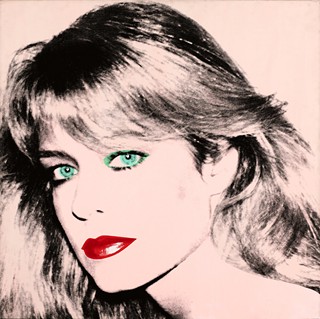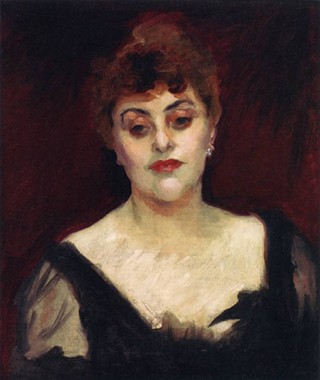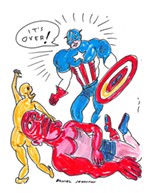‘Those Lips, Those Eyes’
Reading between the features in the Blanton's 'About Face'
Reviewed by Robert Faires, Fri., Aug. 5, 2011
Portraiture is serious stuff.
That may be news in this age of photography when we're all so accustomed to having our images recorded frequently and always in a state of cheerfulness. The camera may be whipped out at any moment, for any occasion – we're at the Grand Canyon, at our best friend's wedding, at happy hour! – and when the lens is pointed our way, reflexively, we smile. For us, portraits are inexorably linked to documenting that we had a good time.
But in the 40 works that make up the Blanton Museum of Art's current exhibit on portraiture, there's scarcely a smile to be seen. Virtually all of the portraits, which range from the third century to the present day, project an air of gravity. The closest you get to the kind of sunny snapshot we know today is Mortimer Menpes' Portrait of Whistler in White Ducks (circa 1879-81), in which the painter who so famously rendered his mother in somber profile, swathed in the black of mourning, is depicted with legs spread in a jaunty stance, jacket open, one hand in the pocket of his white pants, looking as if he's been stopped on a springtime stroll through Kensington Gardens. His bouncy demeanor – enhanced by a pair of sketches floating around this figure that show the artist playfully twirling his mustache – proves the exception in the show. By and large, "About Face" contains as sober a collection of countenances as you'll find outside a jury box or funeral home.
What is it about the formal portrait that prompts such solemnity? Perhaps the weight of posterity was pulling down the corners of these sitters' mouths. Each posed with the knowledge that the visage recorded would outlast their passing, and when gazed upon some decade or century or millennium hence, wished to be seen as a person of substance. That might account for the look of virtuous longing in the eyes of Lady Hamilton, painted by George Romney (1791), in her wedding dress, hands pressed together prayerfully, head turned back over her shoulder as if she's been interrupted in some petition to the lord. (Then again, given Romney's predilection for using the lady as his model and that erupting Vesuvius in the background, this may represent some fantasy he's projected onto her.)
Or maybe all those serious expressions were just borne from the need for the subject to be as still as possible for the time it takes an artist to paint or sculpt one's likeness. Mona Lisa and her celebrated smile notwithstanding, an expression of sobriety is a lot easier to hold for a long period. The facial muscles are relaxed; they aren't fighting to maintain that appearance of spontaneous elation that fades so quickly (as anyone who's had to prolong a smile for that third, fourth, or umpteenth take of the class reunion/going-away party/family holiday card photo can attest).
That said, such stillness also encourages introspection. Whatever else may be occurring while the portrait is being created – the artist chatting, people moving about, a boombox blaring – the subject remains stationary, which leads to an unusual awareness of one's own body, a consciousness of breath and muscle and time passing, that makes it quite easy to slip into a reverie about one's life, to contemplate one's experiences and existence. Many of the portraits here suggest that sort of self-reflection, with the subjects' consideration of self rising to the surface and settling in their features, where their history may be captured by the portraitist. In these, the face becomes a novel wherein a life may be read.
Often the story starts in a single feature. In Eugène Delacroix's Portrait of Charles de Verninac, the Artist's Nephew (1826), Verninac's lips boast the rosy fullness of youth, ripe for kisses and tasting life's pleasures. And yet they're drawn into a dispassionate line, the absence of a smile suggesting some conflict that prevents this young dandy from indulging himself. Unrequited love, perhaps? Familial obligations? A mad missus locked up in the attic? The lips in Farrah Fawcett's portrait by Andy Warhol are even more pronounced, painted a scarlet more lurid and luminous than neon. Flaring from a black-and-white photograph of the actress shortly after her Charlie's Angels heyday, these unsmiling lips suggest an artificial sexuality, excessive and forced. Her similarly colorized eyes staring out almost accusingly at the viewer tell the tale of a woman trapped inside her own beauty, seething at being reduced to a carnal commodity.
Charles Umlauf's bronze of Fawcett, cast during her days as a University of Texas art student in the late Sixties, spins a different story. Though dominated by her hair, which covers her head and drapes her shoulders like the thick, scrolled trunk and roots of a great oak, the soul of the portrait is in the eyes: hauntingly sad, on the verge of tears. They bespeak some kind of loss and uncertainty, possibly from the past but perhaps related to a future this young woman cannot see.
Ah, the eyes. Those orbs can tell so much. In some works, such as George Benjamin Luks' Elsie (1930), they burn with a mysterious flame, a cold fire that hints at some deep resentment carefully contained. In others, their fire has all but burned out. In Bajo sospecha (Under Suspicion) (1998), Chilean artist Bernardo Oyarzún Ruiz has photographed himself in the manner of a mug shot, his response to being wrongfully arrested because he was thought to resemble the suspect in a police sketch. His narrowed eyes set in a haggard face might as well be charcoal, they're so blackened and burnt. They belong to someone beaten down by prejudice and injustice to the point that he is spent.
So many of the eyes here are hooded, the lids slipping down as if weighted by the burden of existence. They stare out from under the cocked brow of the emperor Marcus Aurelius' marble bust (210) as if to say, "What, you ask still more of me, Rome?" They peer languidly out from Francesco Curradi's Portrait of a Man, Bust Length, in a Black Coat With a Lace Collar (1611) with the fatigue of one who has lost all reason to live. They peek out – just barely – from under the arched brows and painted lids of John Singer Sargent's Madame Belleroche (1884), so wearied by the social whirl season after season that she can no longer lift them to meet the gaze of the viewer.
Indeed, we don't always grasp how much eyes reveal until they're hidden from us, as in Arrangement in Subtle Tones: Elsie (2009), by Austinite Graydon Parrish. The young woman with the porcelain skin has an almost ethereal beauty about her, but we're kept from seeing any sense of her internal life because her eyelids are nearly closed, her long, blond lashes obscuring what little of her pupils are visible. Whether she's done this in modesty or sorrow is unclear, but her expression is blank, as composed and impassive as a mask. You're drawn to keep looking at her, not merely by the exquisite delicacy of her features but also by hoping against hope that she might lift her lids and expose those eyes to us.
Not all of the exhibit's works focus on the face or offer strictly naturalistic representations of the subject in portrait, but it's the faces that draw us to linger, that invite our study. It's only natural, for that is where we go first in communicating with one another: the source of speech, those windows to the soul. It's where we first note the marks of time – the crow's feet, the laugh lines, the sagging skin. It's where so many of our stories lie. "About Face" offers us so many stories in countenances worth studying. This summer's best beach read might be had in a museum.
"About Face: Portraiture as Subject" is on view through Sept. 4 at the Blanton Museum of Art, MLK & Congress. For more information, visit www.blantonmuseum.org.















